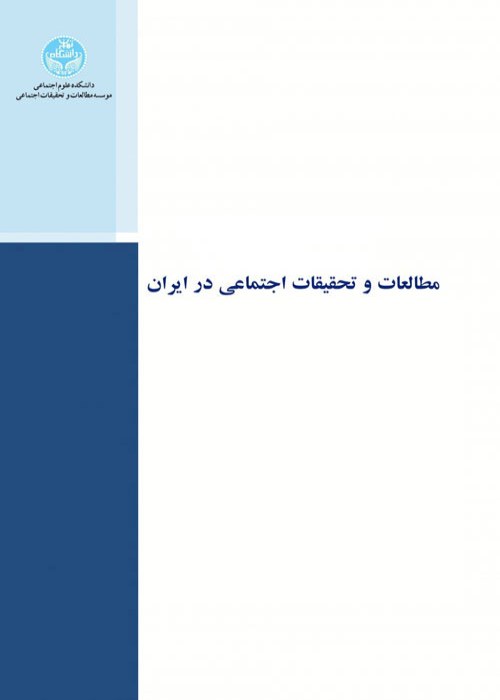Representation of Religiosity Dimensions of Social Classes: A Study of the Iranian Cinema following 1979 Revolution
Author(s):
Article Type:
Research/Original Article (دارای رتبه معتبر)
Abstract:
Introduction
Religious identity has been one of the most important aspects of shaping the social identity of individuals and social groups in Iran, and such a major and fundamental force has historically played a role in social changes in Iran. Moreover, religious identity is not a closed and homogeneous whole and has a variety of dimensions and components. On the other hand, the media, especially cinema and television, are not always detached from their social and political space, so they represent the content of their message, influenced by the dominant socio-political discourses, in a special way, highlighting a number of dimensions and ignoring others. Method
This study seeks to study how different religiosity dimensions of social classes are represented in post-revolutionary Iranian cinema. The dimensions of religiosity considered in the present study are derived from the Glock and Stark's model of religiosity, as well as the implications of the class is based on Pierre Bourdieu's theory of distinction in which, the composition and volume of various capitals are involved in the class formation. Finally, these two theoretical levels are analyzed in the context of Stuart Hall's constructivist approach to representation. Out of the dozens of movies in Iranian cinema, two levels of theoretical and typical sampling was conducted and finally two film in each decade that were theoretically more closely aligned with the research criteria were selected and analyzed. The films included: Pure Repentance (1983), Two Blind Eyes (1984), from Karkheh to Rhein (1991), Smell of Camphor, Scent of Jasmine (2000), A House Built on Water (2001), Book of Law (2008), Scandal (2012) and Sensitive Class (2013). These films have been examined by John Fisk's Critical Semiotics at three levels of "reality, representation, and ideology". Results and discussion
Finally, the combination and integration of the first two levels is represented in the last level, i.e., ideology. Critical semiotics of films have also shown that the representation of the five dimensions of religiosity of each social class, influenced by the discourses of each decade, has undergone significant changes, including reduction in the religiosity dimensions of the lower class, especially emotional dimension, compared to the 1960s, the relative stability of the dimensions of middle-class religiosity from the 1970s onwards, and the growing emphasis on the ritual dimension of religiosity of the upper class in the last decade. Such changes and fluctuations in the representation system of cinema itself have been affected by changes in the discourses that govern each decade. Conclusion
The results of this study, on the other hand, confirmed that cinema, based on its representative nature, show the complex relations between the fundamental forces in Iranian society, namely religiosity and class relations, through the lens of cinema. It is important to note, however, that in comparison with literature of the study, which considers "religious cinema" to be stable in contrast to current trends in society, or without considering class formations, or impose single discourse on "Religious subjects", this study shows that despite the existence of specific political, social and economic discourses in each decade, such discourses do not affect the dimensions of religiosity of all classes in a similar and integrated way, moreover, representation of the dimensions of religiosity of different social classes have had significant fluctuations and changes.Keywords:
Language:
Persian
Published:
Quarterly of Social Studies and Research in Iran, Volume:9 Issue: 4, 2020
Pages:
995 to 1026
magiran.com/p2209774
دانلود و مطالعه متن این مقاله با یکی از روشهای زیر امکان پذیر است:
اشتراک شخصی
با عضویت و پرداخت آنلاین حق اشتراک یکساله به مبلغ 1,390,000ريال میتوانید 70 عنوان مطلب دانلود کنید!
اشتراک سازمانی
به کتابخانه دانشگاه یا محل کار خود پیشنهاد کنید تا اشتراک سازمانی این پایگاه را برای دسترسی نامحدود همه کاربران به متن مطالب تهیه نمایند!
توجه!
- حق عضویت دریافتی صرف حمایت از نشریات عضو و نگهداری، تکمیل و توسعه مگیران میشود.
- پرداخت حق اشتراک و دانلود مقالات اجازه بازنشر آن در سایر رسانههای چاپی و دیجیتال را به کاربر نمیدهد.
In order to view content subscription is required
Personal subscription
Subscribe magiran.com for 70 € euros via PayPal and download 70 articles during a year.
Organization subscription
Please contact us to subscribe your university or library for unlimited access!



